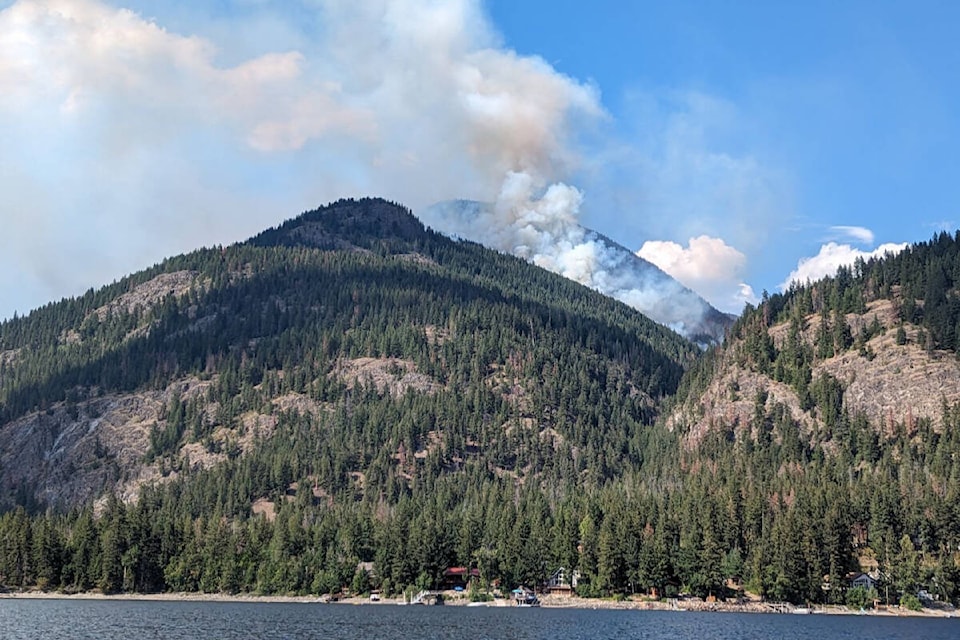By Jim Cooperman
Contributor
Most of British Columbia’s destructive wildfires began as small, insignificant blazes, many sparked by lightning that could have been put out early if there had been an effective initial attack.
The Shuswap Firestorm was no exception to this all too familiar pattern that now, due to climate “boiling” as the UN Secretary-General has called it, is rapidly becoming a crisis of epic proportions.
The East Adams Lake wildfire began on July 12 after a lightning strike ignited a tree, which then spread quickly. That same evening, another lightning strike started the Bush Creek fire.
During the next two days both fires were actioned by bucketing helicopters, which left them smouldering.
A rapattack crew arrived by helicopter to begin putting out the East Adams Lake wildfire, but they needed water, which never arrived so they left.
Before the policies were revised, often the first firefighters to arrive were local logging contractors who are working nearby and have the equipment and expertise to put fires out before they become a problem.
Under the current rules, only the BC Wildfire Service professionals are allowed to fight fires, so when a logging contractor who had equipment nearby, offered to put the Adams Lake East fire out, he was told that if he did, he would be taken to court.
Ironically, that same contractor had put out another wildfire to the north earlier that week without first asking for permission.
From July 15 to 17, the fire was actioned by water skimmers and a single helicopter to primarily protect the south flank and prevent it from moving towards lakeside homes.
After that weekend, there was no action on the fire as BCWS announced it was letting it burn because it was in inoperable terrain and primarily moving northward. Still, BCWS also reported in media updates that helicopters were actioning the southern edge of the fire, which was not the case.
On July 20, the fire exploded high up on the hillside above the lake and was visible from Squilax, where I took a photo and sent it to our area director, Jay Simpson, to raise the level of concern.
The BCWS made sure the Adams Lake community was put on evacuation alert, but they did not have any ground crews actioning the fire.
Read more:
Read more:
The Adams Lake communities utilize the Neighbourhood Emergency Program that includes a communication channel to the CSRD, which they used to request more action on the fire. Despite the pleas from the CSRD, no action was taken so the community appealed directly to the BCWS without success. On the 24th the CSRD brought a Structure Protection Unit (SPU) trailer to the community where it was stationed to be used if needed.
With the fire now just two kilometres away, the communities sent a formal letter of concern to the CSRD and the BCWS and were told “an elite team of wildfire professionals are being assigned to this wildfire.”
Finally, on July 26, the BCWS met with the community and promised they would begin fighting the fire directly, while the CSRD promised another SPU trailer and told the community, “The good news is we have time.” A request was made for a fire guard to be built, but that fell on deaf ears.
When one resident explained the community had lost faith in both agencies and that he and others would defy evacuation orders, the CSRD responded aggressively, saying it would set up a log boom to cut off lake access to their properties. The SPUs arrived on July 28 and took three days to set-up, with one not functioning due to failed pumping unit. Three days later the SPUs were demobilized and taken to other fires as BCWS released a 10-day modelling report that the fire did not pose a threat.
Two communities were taken off evacuation alert while Dorian Bay was left on due to its proximity to the fire.
The winds shifted Aug. 2, as they had before, and yet this had not been predicted in the modelling report.
As the fire grew closer, communities sent emails directly to the BCWS due to the poor response time from the CSRD. They were told “there is currently no threat to communities,” even though BCWS knew that the fire was close because there were helicopters actioning it.
By 5:44 p.m. the fire was just 100 metres away from homes and residents began fighting it. Finally, an hour later, skimmer planes arrived to action the blaze with water and retardant to protect structures.
As many residents evacuated by boats and the ferry, others remained to deploy their own structure protection systems to save their homes.
Thankfully, the winds shifted in time and the fire headed back up the hill.
The inadequate initial attack, the policy to not allow local contractors to action fires, the lack of attention to the fire when it was small, the poor communication with residents, and the failure to assess the risks and adequately protect structures led to the near disaster on the 22nd day of the fire.
This mismanagement was clearly a forewarning of what lay ahead.



